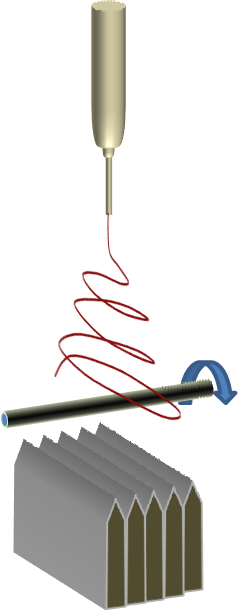Tube Extraction from Rod
 Figure 1. Electrospun tube after removal from template rod |
Direct electrospinning of nanofibers onto a metal rod is one of the simplest methods of fabricating nanofibrous tube. While coating a rod with nanofibers is simple, removal of the tube from the rod is often a challenge without damaging the tube in the process. Since electrospun fibers membrane is known to adhere onto the collector plate, the same goes for the deposited fibers on a rod. In cases where high rotation of the rod is required for the purpose of getting aligned fibers, this further exacerbates the difficulty in removing the tube. Nevertheless, there are a few possible methods of getting the constructed tube off the collector rod.
Dipping in ethanol/water mixture
An ethanol/water mixture is able to wet and penetrate through the fibers to the rod. This potentially creates a lubricating interface between the fibers and the rod which may facilitate the smooth removal of the tube from the rod. Other liquid with low surface tension or surfactant may also be used.
 Figure 2. Guiding electrode to direct electrospinning jet. |
Non-stick surface
A non-stick surface may be created by applying Teflon coating on the rod. Teflon tubes/rod or other non-stick material may also be used as the template. However, as these surface may be non-conductive, the electrospinning jet may not deposit on it. A possible remedy for this will be to use a guiding electrode below the rod to direct the spinning jet. With the rod positioned along path of the jet between the nozzle tip and the guiding electrode, the fiber will be gathered by the rotating rod.
Using separating medium
Prior to depositing the fibers on the rod, a separating medium such as alginate solution may be used to coat the rod. Once the alginate dries, electrospinning may be carried out to deposit fibers on the rod. To remove the tube from the rod, dip the coated rod in water so that the water soluble alginate will dissolve and frees the tube from the rod. Wu et al (2023) used Pluronic F127 hydrogel to coat on the surface of the stainless steel rod prior to electrospinning. After the desired layers of nanofibers were deposited on the coated rod, the rod with the nanofibers was chilled to between 0 to 4°C to liquefy the F127 so that the electrospun tube can be removed from the rod easily. Residual amount of F127 may be removed using absolute ethanol.
Spiral wire on rod
In a technique developed by Errico et al [2011], a mechanical means of creating a removal barrier between the deposited fibers and the rod is to have a wire coiled around the rod prior to fiber deposition. After the fibrous tube is formed on the coiled wire, the inner rod may slide out from the coiled wire. The coiled wire now freed from the supporting rod can be removed from the inner wall of the fibrous tube. See figure 3 for a schematic illustration of the method.
 Figure 3. Step A: Coil a wire onto the rod; Step B: Carry out electrospinning to deposit fibers on the coiled rod; Step C: Slide the rod out from the wire; Step D: Uncoil the wire beneath the electrospun fiber tube [Errico et al 2011]. |
Last updated: 29 August 2023
 ElectrospinTech
ElectrospinTech